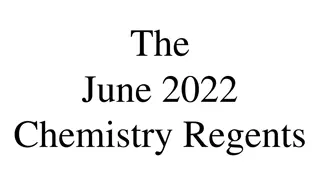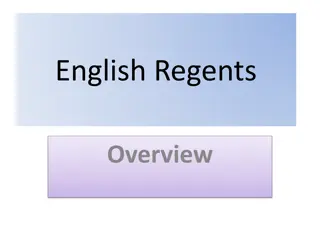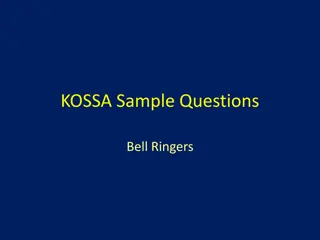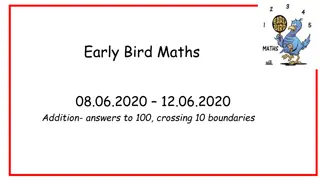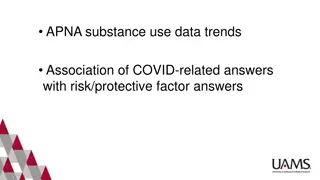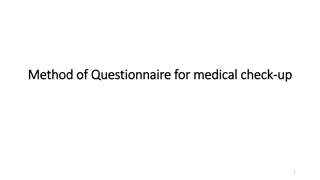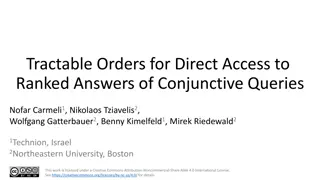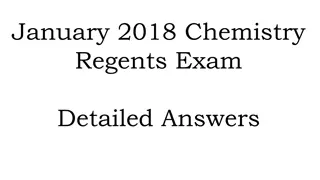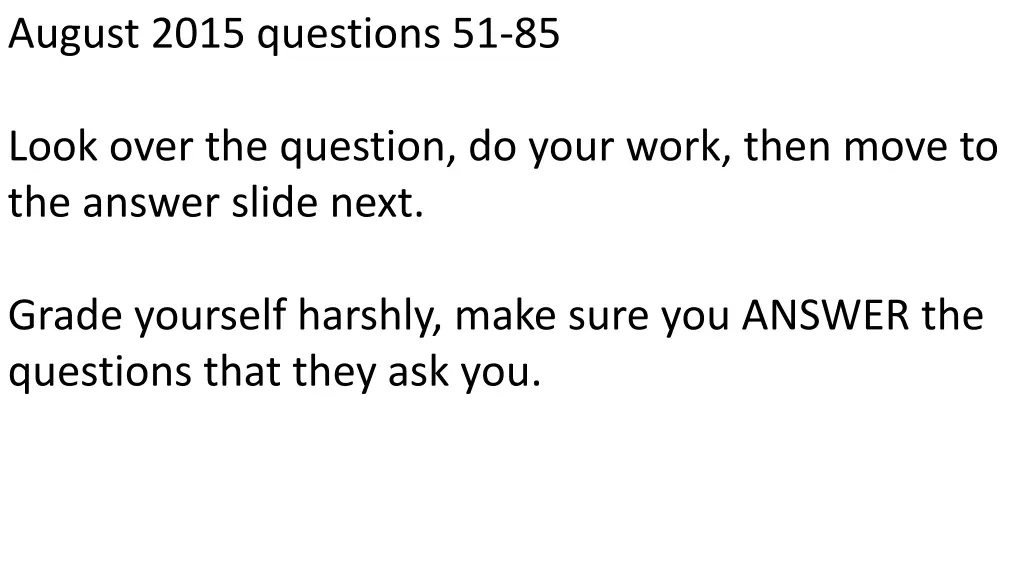
Chemistry Concepts from August 2015 Questions
Explore various chemistry questions from August 2015 covering topics such as vapor pressure, entropy, molecular formulas, atomic mass, phase changes, acids and bases, and more. Test your knowledge and understanding of these fundamental concepts in chemistry.
Download Presentation

Please find below an Image/Link to download the presentation.
The content on the website is provided AS IS for your information and personal use only. It may not be sold, licensed, or shared on other websites without obtaining consent from the author. If you encounter any issues during the download, it is possible that the publisher has removed the file from their server.
You are allowed to download the files provided on this website for personal or commercial use, subject to the condition that they are used lawfully. All files are the property of their respective owners.
The content on the website is provided AS IS for your information and personal use only. It may not be sold, licensed, or shared on other websites without obtaining consent from the author.
E N D
Presentation Transcript
August 2015 questions 51-85 Look over the question, do your work, then move to the answer slide next. Grade yourself harshly, make sure you ANSWER the questions that they ask you.
51. At 90C, the vapor pressure for ethanol is 150 kPa. 52. Solids have less entropy than solutions. Solids are stuck , and the particles stay very orderly. Aqueous solutions are in constant motion - and they have more entropy, more disorder. 53. Guess - I started with 6, but I had to change it to 4 4X CH2O. C4H8O4 4x12= 48 8x1= 8 (you may have to guess at this, 4x16 = 64 then adjust your thinking). = 120 g/mole 54. NaCl is an ionic compound, formed by cation and anion attraction. This diagram shows a molecular (or covalent) sharing of electrons, not the transfer of electrons that really happens with this compound.
55. Gram formula mass means molar mass, but you would do easier work with a molecular formula rather than this structural diagram. So, change it to C7H14O, and do the math. C7H14O 7x12= 84 14x1= 14 1x16 =16 = 114 g/mole 56. The mass of a proton is about 1 AMU. The mass of an electron (in high school) is zero. It s not really zero, but it s about 1/1700 of an AMU. Practically zero. 57. (3.28 X 1024) X (0.0107) = the number of C-13 atoms in this sample.
58. It starts as a liquid at A. The boiling point is the flat part of the graph at B to C , which is 95 C. 59. Since temp is constant even though heat is being added, the kinetic energy is also steady. So, the potential energy increases as the substance moves up from liquid to gas phase.
60. The dread hydronium ion again! Nitric Acid (table K) is HNO3(AQ) which puts H+1 cations and NO3-1 anions into solution, but in this question, you must use the H3O+1 ion instead of the (correct) H+1 cation. 61. Methyl orange changes color from RED to YELLOW from pH 3.1 to 4.4 Nitric Acid is a very strong acid (lots and lots of H+1 cations in solution, so, the pH is low, and it s given in the question as pH 1, although you see how they made the wording funky to throw you off. It s RED.
62. This is fission, the splitting of a larger atom into smaller daughter nuclei . Here, the larger U-235 is transmuted artificially with a neutron, and the result is two smaller isotopes of Xe and Sr. Additional neutrons (and energy) generated make the next loop of this chain reaction bigger (and bigger and bigger). 140 54 0 140 55 63. e + Cs Xe -1 64. It is four Half Lives in time to get down to just 1.5 grams left. Each half life for Sr-94 is 29.1 years (I didn t know that. I put my finger into the right box on Table N). 4 x 29.1 years = 116.4 years 24.0 g 12.0 g 6.0 g 3.0 g 1.5 g 64. NOW one two three four HL HL HL HL
65. Sr-94 emits BETA particles, which is on table N. These are NEGATIVELY CHARGED, and when they are shot out of the lead box, in a straight line, they should go straight. But when they are shot through this set up (like a cathode ray tube) they are attracted to the top, positively charged plate. They are deflected towards that, which is shown in RED.
66. There are 2 atoms of Sb in Sb2S3. each Sb = 122 AMU on the periodic table. Mass part Percent comp = X 100% = Mass whole 244 g Percent comp = X 100% = 72% Sb by mass 340 g 67.Average weighted Atomic Mass of Sb (120.90 amu) (0.57) = 68.913 (122.90 amu) (0.43) = 52.847 add these up . = 121.76 AMU 68.
69. Ammonium chloride is NH4Cl which is an ionic compound. It has ionic bonds. In the ammonium ion there are four H atoms bonded with just one N atom, which are polar covalent. This compound has 2 kinds of bonds: ionic AND polar covalent. 70. The solution has so much solute, because some excess solute remains on the bottom of the beaker, that means it is already a saturated solution. 71. The water starts at 25.8 C, but when NH4Cl is dissolved, the temperature of the solution drops to just 11.2 C. That is absorption of energy = endothermic. 72. If step 3 is done at 98C, much hotter, all the NH4Cl would dissolve, none would remain at the bottom of the beaker. It s usual for HOTTER solutions to hold more ionic solute than cooler ones.
74. 73.
75. Sodium chloride dissolves into the ice, lowering the freezing point hopefully below the air temperature, which lowers the freezing point (melts) of the ice, making the roads wet but not slippery. 76. Acceptable responses include: The sample is greater than 25% NaCl by mass. or The ratio by mass of sand to NaCl in the sample is 2 to 1. or The mass of the salt is too great.
77. There are two products, PbI2 is INSOLUBLE on table F. NaNO3 is soluble (AQ) on table F. 78. The balanced equation is this: Pb(NO3) 2 + 2NaI PbI2 + 2NaNO3 so 13.2 grams + 12.0 grams forms 18.4 grams + X grams solving for X, X = 6.8 grams NaNO3 this was a LAW OF CONSERVATION OF MATTER PROBLEM, easy math
79. Both contain the OH group, they are both ALCOHOLS. 80. If they are insoluble in POLAR water, then they must be NONPOLAR molecules. Water is polar and dissolves only polar compounds (some exceptions are not soluble like AgCl. All polar molecules in high school dissolve in water. Like dissolves like.
81. Mg(OH)2(S) + 2HCl(AQ) MgCl2(AQ) + 2H2O() 82. Before you eat this magnesium hydroxide the acid in your stomach is strong: you have a high concentration of H+1 cations, with a low pH. After eating the antacid, you have a much a much LOWER CONCENTRATION of H+1cations, and a HIGHER pH.
83. This was called oxidation because the carbon reacts with (and combines with) oxygen. 84. Carbon starts at 4 and changes to +4. 85. Mg Mg+2 + 2e




